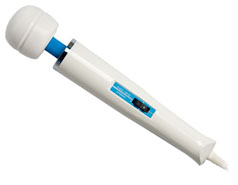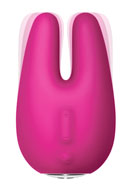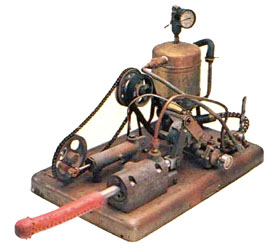
The history of sex toys
Have you ever wondered how sex toys came to be? Well, the story involves dubious medical conditions, goat eyelids, hilarious magazine ads, dragon tongues, and a cast of characters that ranges from a former police officer to a ventriloquist. Intrigued? Read on…
A long time ago — 1000 A.D.

Nobody knows quite when the dildo was invented. It likely dates all the way back to the Upper Paleolithic period. Phallic objects from this period are sometimes labeled by archaeologists as “batons,” but they might very well have been used for sexual stimulation. One particular 20-centimeter siltstone phallus, estimated to be about 28,000 years old, was discovered in a cave in Germany.
Dildos can also be found in Greek vase art from the 6th century B.C., in depictions of both group sex and solitary female masturbation. Around this time, an early version of the dildo called the “olisbos” was invented in the Greek port of Miletus. Olisbos were sold by traders around the Mediterranean.
Olive oil may have been one of the first lubricants. It was promoted for contraception starting in about 350 B.C.
Ben wa balls were invented around 500 A.D. These little balls — some solid, some hollow with “clappers” inside that created a ringing sound — were inserted into the vagina. They were originally meant to provide pleasure to a man during intercourse, but their ability to improve the pelvic floor muscles was eventually discovered.
1000 — 1800
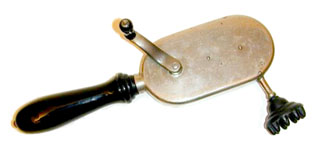
Cock rings first appeared around 1200 in China. They were made from the eyelids of goats… with the eyelashes still intact. These cock rings were flexible and had to be tied around a man’s erection. Why the eyelashes? Well, they were thought to amplify the pleasure of sex.
Around 1400, the word “dildo” was coined — perhaps from the Latin dilatare, “to open wide,” or maybe from the Italian diletto, “to delight.” Dildos in this period were made of wood, stone, leather, tar, and other firm materials, and required a copious amount of lubrication (again, olive oil) for pleasurable use.
By 1600 or so, cock rings had evolved quite a bit. They were now stiff ivory rings that Chinese men used to maintain their erections. The rings were ornately carved, usually with depictions of dragons. Over time, the dragon design became more and more intricate, until finally the dragon’s tongue extended beyond the ring, creating a nub that stimulated the clitoris during intercourse.
A primitive version of the vibrator popped up in 1734; it was powered by a hand crank.
1800s

Not much is known about the history of the butt plug, but during the Victorian era, one European doctor suggested that his patients insert a wooden egg anally. It was believed that pressure against the prostate gland would guide semen back to the bladder, thereby preventing “wasteful ejaculation.”
1869 was a landmark year in the history of sex toys. For centuries, doctors had been treating women for a plethora of illnesses (most notably hysteria, which had symptoms very similar to those of sexual arousal) with what they politely called “pelvic massage.” The point was to induce “hysterical paroxysm” — yes, orgasm — in the patient.
Hysteria was a recurring condition, of course, and doctors grew tired of the time-consuming treatment, complaining of fatigued wrists and hands. In an effort to aid them, an American physician named George Taylor, M.D. invented a hulking, steam-powered device called the Manipulator. The engine of the machine was so monstrous that it was hidden in another room, while the apparatus was threaded through a hole in the wall.
Thankfully, the Manipulator was usurped by the first electromechanical vibrator, invented in 1882 by British physician Joseph Mortimer Granville. This vibrator was battery-powered and came with several attachments with which to vary the sensation. Granville did not approve of his device being used on women; he insisted it was for massaging men’s skeletal muscles. But it was too late; the vibrator was off to a running start.
1900 — 1952
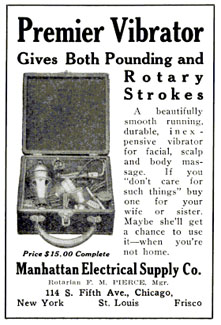
As electricity entered homes around the U.S., the plug-in home vibrator experienced a surge in popularity. In fact, vibrators were the fifth domestic appliance to be electrified, right behind the sewing machine, fan, tea kettle, and toaster, and about a decade prior to the vacuum cleaner.
Consumer magazines such as Home Needlework Journal and Woman’s Home Companion featured advertisements for vibrators, touting them as wonderful health and relaxation tools that could cure headaches, wrinkles, and nerve pain. Yet there was an element of playfulness to some of the copy — for example, “all the pleasures of youth… will throb within you.”
Sadly, all of that cheerfulness came crashing down in the 1930s. The vibrator had become more and more prevalent in pornographic films, and manufacturers could no longer pretend that their products were innocent “massagers.” Vibrator advertisements vanished.
In 1952, the American Medical Association concluded that hysteria was not a true ailment. This was the final turning point — the vibrator could no longer hide behind its medical use.
1960 — 1990
In 1966, a middle-aged ventriloquist named Ted Marche pioneered the manufacture and distribution of rubber dildos and other sex toys. By 1976, Marche Manufacturing had sold nearly five million toys — and paved the way for countless others.
The Hitachi Magic Wand, made by Japanese manufacturing firm Hitachi, first appeared on the North American market in the 1970s. The Magic Wand’s stated purpose is to massage sore muscles and nerves, but its use in porn eventually made it famous among sex toy users. To this day, few sex toys are as well-known and well-loved as the Hitachi (although it underwent a name change and now has competition).
In 1980, KY jelly finally went over the counter as a sexual lubricant. Since its inception in 1927, it had been used by physicians during pelvic exams. This opened the flood gates, and a huge variety of lube is available today, including special flavored and stimulating gels.
1990s
Things really began speeding up in the ’90s. Vixen Creations, San Francisco-based manufacturer of 100% silicone sex toys, was founded in 1992. German company Fun Factory, known today as the company that makes cute, brightly-colored toys, came along in 1996. Tantus joined the party in 1998.
The rabbit vibrator, a type of dual-action toy named after the shape of its clitoral stimulator, experienced an explosion in popularity in 1998 when it starred in HBO’s multi-award winning TV show, Sex and the City. Even recent interest in this type of toy can be attributed to the single episode in which Charlotte becomes obsessed with her rabbit.
1998 was also the year the Fleshlight male masturbation sleeve was patented (hilariously, the patent calls it a “device for discreet semen collection”). A former police officer named Steve Shubin came up with the idea when his wife had a high-risk pregnancy and the couple was advised not to have intercourse. Shubin hired models, took casts of their genitalia, then re-created them in a flesh-like material. He disguised each realistic sleeve in a faux flashlight case, and the name “Fleshlight” was born. The Fleshlight is now the best-selling male toy of all time.
2000s — today
Business is booming! Luxury Swedish sex toy company LELO was founded in 2003, and they were the first to create a rechargeable vibrating cock ring, as well as a USB-rechargeable clitoral vibe. Jimmyjane, another manufacturer of high-end toys, was founded in 2004. Stainless steel sex toy manufacturer njoy and wooden sex toy company NobEssence followed in 2005. In 2006, a former Apple employee partnered with her husband to create the world’s first music-driven vibrators.
In 2008, the public was introduced to the first sex toy that remembers what its user likes, the now-discontinued Je Joue SaSi, causing awe among consumers at how advanced sex toys have become.
Now, the market for luxury sex toys is fierce, and innovative toys (such as the Sqweel, Cobra Libre, and Stronic Eins) are being released often. The traditional rabbit vibrator has evolved and been re-imagined. Many vibrators are rechargeable, waterproof, and powerful, all at the same time. And dildos now come in a vast variety of materials, although they always have — but supple pure silicone is definitely an improvement over tar.
Where are sex toys headed next? Some predict advanced phone apps, virtual sex, and biometric controls that respond to moods, body heat, and even brainwaves. Others simply imagine an increase in hygienic materials and eco-friendly options. What would you like to see?

